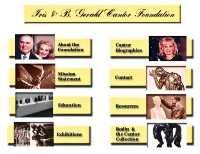|
Los Angeles County Museum of Art
December 12, 1996 - March 2, 1997
Los Angeles, California
Philadelphia
Museum of Art
March 27 - June 22, 1997
Philadelphia, Pennsylvania
Brooklyn Museum
of Art
July 18 - September 28, 1997
Brooklyn, New York
Museum of Art
Brigham Young Univerity
October 24, 1997 - January 24, 1998
Provo, Utah
Arkansas
Arts Center
February 13 - May 17, 1998
Little Rock, Arkansas
Portland Art Museum
June 1, 1998 - August 31, 1998
Portland, Oregon
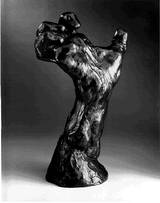
Large Right Hand, clenched
From the CityPaper.net article
|
"The Hands of Rodin: A Tribute to B. Gerald Cantor's Fifty Years of
Collecting" was organized by the Iris and B. Gerald Cantor
Foundation and Rachael Blackburn, Curator of Exhibitions at the
Foundation. The exhibition also served as a testament to the enthusiasm
of Gerald B. Cantor, who died in 1996.
In her extensive
article for Citypaper.net, Daisy Fried let LACMA´s Curator Mary
Levkoff explain the concept behind the exhibition:
— Rodin was fascinated by hands. He modeled
thousands, many of them rapid clay sketches which captured them in all
their angles and shapes. He kept these 3-D sketches around his studio,
studied them as independent forms. He believed the hand didn't depend
upon the body to convey meaning. He also tried them out at various
angles when he composed new figures. In Hands of Rodin, the same hands
can be seen several times on different pedestals, some smaller, some
larger.
— The hands' expressive capability is huge. Rodin's
hands clench, beg, pray, piano-play, show disease. A vitrine of 26 small
ones is one of the most enchanting parts of the show. People argue about
the meaning of hand gestures in Rodin's sculptures. For instance, is
John the Baptist beckoning or blessing?
— The hand is symbolic. A central piece, The Hand of
God, uses a hand to symbolize the creator of humankind. A huge hand
cradles a nude man and woman, who may be in the act of procreation
themselves. Rodin thought of the hand of the artist-creator as akin to
the hand of God the creator.
Ironically, then:
— The hand of the artist is not necessarily necessary.
Many of the Rodins in the Rodin Museum were cast after
the artist's death. So were a number of the works in the Hands show,
including two versions of She Who Was The Helmet Maker's Beautiful Wife,
a sculpture of a nude old woman.
|
|
www.cummer.org
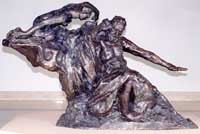
The practice of casting posthumous bronzes is not
without controversy. Gary Arseneau, a Fernandina Beach-based artist and
gallery owner, argued that the Monument to Victor Hugo and other
sculptures in the exhibit should be clearly labeled ''reproductions
posthumously manufactured after Rodin's death with reproduced Rodin
signatures'' since they were not completed until after Rodin had died
and could not have been signed by him.
Museum officials and Rachael Blackburn, representing
the Cantor Foundation, replied posthumous casting of bronzes is common
practice, that the process used in creating this bronze conforms to
French law, and that the date on the posthumously cast bronzes makes it
clear they were executed after Rodin's death.
The other three Museums hosting this exhibition:
Los Angeles County
Museum of Art
17 Dec. 1998 - 15 March1999
Los Angeles, California
Portland Art Museum
13 April 1999 - 11 June 1999
Portland, Oregon
The Metropolitan
Museum of Art
6 Oct. 1999 - 2 Jan. 2000
New York, New York
|
Cummer Museum of Art & Gardens
829 Riverside Avenue
Jacksonville, Florida
32204 USA
Tel. 001 - 904 - 356 68 57
Fax 001 - 904 - 353 41 01
Curatorial: Maarten van de Guchte, Ext. 216, maarten@cummer.org
Exhibition:
"Rodin´s
extraordinary Monument to Victor Hugo"
8 July 1999 - 19 Sept. 1999 This exhibition included twenty sculptures by Rodin in bronze,
marble, plaster and terra cotta, as well as several works on paper. The
focal point of the exhibition is Rodin’s bronze Monument to Victor
Hugo. This single sculpture weighs 2,750 pounds and has dimensions of 6’x
9’x 5’. The exhibited copy of the monument, originally commissioned
in 1889, was cast in bronze in 1996 (second cast).Rodins design for the Monument to be placed in front of the Pantheon
had to match Jean-Antoine Injalbert´s Monument to Mirabeau, but since
Rodin choose for a more horizontal view, the dimensions did not fit
together and his design was rejected. The model was rescheduled for
erection in a the Gardens of the Palais Royal.
 The exhibition was accompanied by the book
"Rodin´s Monument to Victor Hugo" by Ruth Butler, Jeanine
Parisier Plottel and Jane Mayo Roos, produced by Merrel Holberton
Publishers, London, 1998. The book documents the history of Rodin´s and
Injalbert´s designs and has very fine photos of the different versions
of the Monument and the various Muses. The exhibition was accompanied by the book
"Rodin´s Monument to Victor Hugo" by Ruth Butler, Jeanine
Parisier Plottel and Jane Mayo Roos, produced by Merrel Holberton
Publishers, London, 1998. The book documents the history of Rodin´s and
Injalbert´s designs and has very fine photos of the different versions
of the Monument and the various Muses.
|
|
http://www.hia.com/rockctr/
www.go-newyorkcity.com/
manhattan/0023index.html
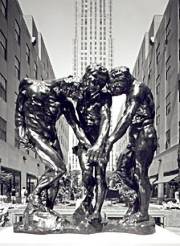
The Three Shades on Fifth Avenue,
bronze, Cantor Collection
Photo: Andrew Moore
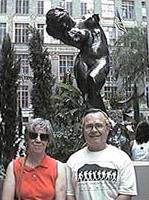
A photo from a personal Website
published by Eileene Coscolluela
|
Rockefeller Center, New YORK
630 Fifth Avenue (at 48th Street)
New York, New York 10020 USA
Tel. 001 - 212 - 332 34 00
Fax 001 - 212 - 332 34 01
The Art Deco office building complex consists of 19 buildings and
scores of upscale shops and restaurants. Since 1932, art has been an
integral part of Rockefeller Center. With over 100 works by more than 30
artists, the Center holds an important public art collection.
From 17 June 1998 - 31 August 1998, the Rockefeller Center showed
eight large-scale bronze sculptures by Rodin on loan from the Cantor
Foundation, arranged in a traditional French Garden setting.
Beginning on Fifth Avenue with The Three Shades, visitors were
invited along the Channel Gardens to a central grove providing an
intimate setting for the Burghers of Calais, alongside Whistler's Muse,
Meditation and Monumental Torso of the Walking Man. The show also
included The Thinker, which had been transported from its traditional
place at Stanford University to New York.
For comments on the Thinker´s trip:
www.news-service.stanford.edu/
opinion/october/column1028.htm
www.stanford.edu/~bkunde/
fb-press/articles/thinker.html
www.stanford.edu/dept/news
/report/news/september27/
column-927.html
|
